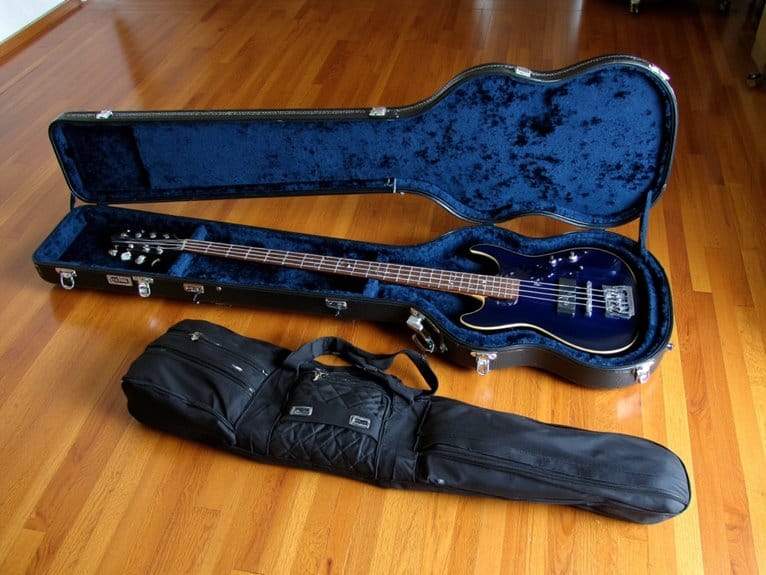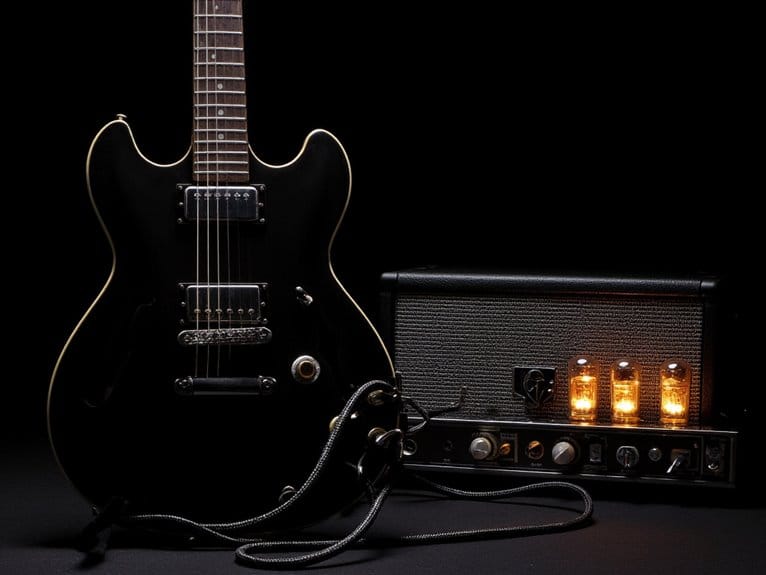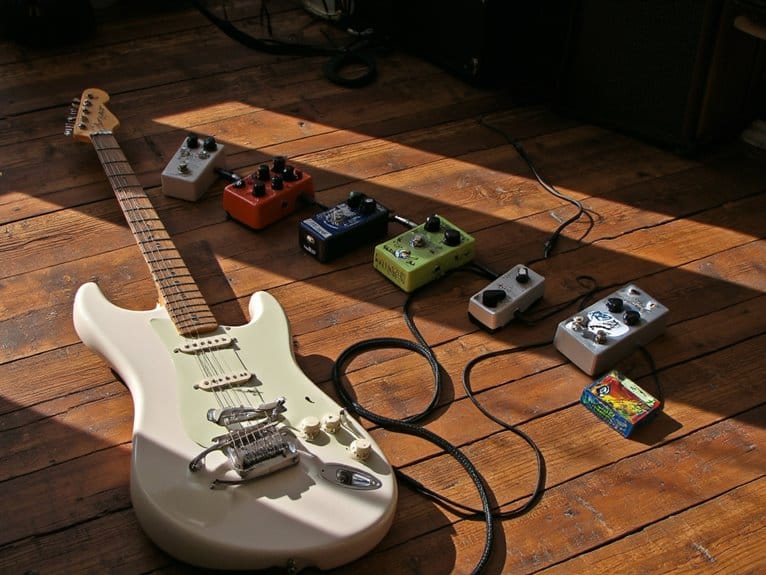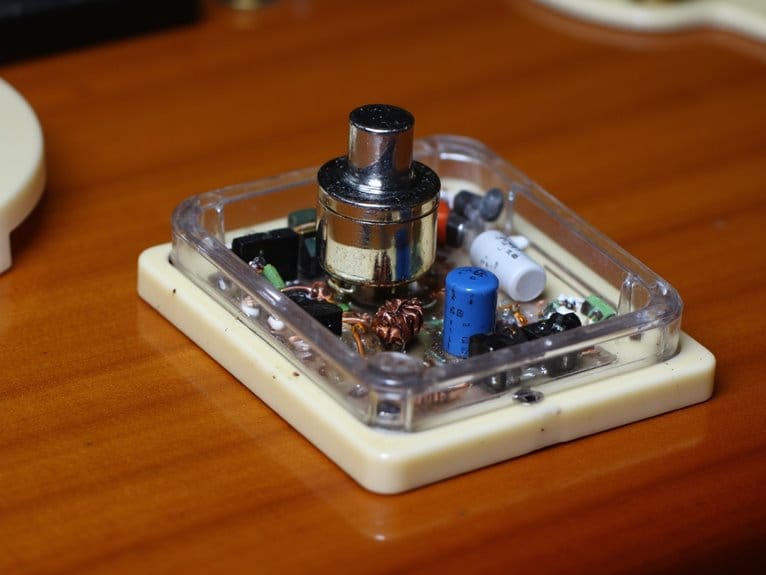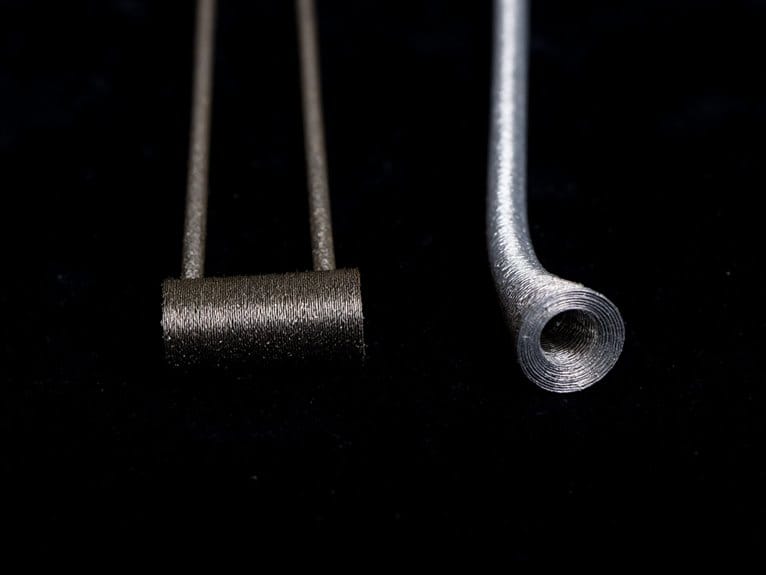Understanding Bass Guitar Cases Vs Gig Bags
You’ll face a fundamental trade-off between maximum protection and convenient portability when choosing bass guitar storage, with hard cases offering rigid ABS plastic shells that weigh 6-7 pounds but provide superior impact resistance, while gig bags sacrifice some protection for their lightweight 1.6-2 pound design featuring padded shoulder straps and multiple accessory pockets. Hard cases excel for airline travel and expensive instruments, whereas gig bags suit local gigs and daily commuting, with costs ranging from $30-90 for bags versus $130-230 for cases. Understanding these specific advantages will guide your decision toward the perfect storage solution.
We are supported by our audience. When you purchase through links on our site, we may earn an affiliate commission, at no extra cost for you. Learn more.
Notable Insights
- Hard cases provide superior protection with rigid shells but weigh 6-7 pounds, while gig bags are lighter at 1.6-2 pounds with less protection.
- Gig bags offer better portability with padded shoulder straps and multiple pockets, whereas hard cases have limited carrying options and storage.
- Hard cases are essential for airline travel and expensive instruments, while gig bags work best for local gigs and daily commuting.
- Hard cases cost $130-230 due to premium materials, while gig bags range $30-90 with budget options providing inadequate protection.
- Hard cases fit standard instrument shapes precisely, while gig bags offer more flexibility to accommodate various bass guitar body shapes.
Protection Level Comparison Between Hard Cases and Gig Bags
Hard cases deliver superior protection features through rigid shells made from ABS plastic or molded materials, creating fortress-like barriers against impacts, drops, and crushing pressure that would devastate your bass in softer storage.
Hard cases create impenetrable shields through rigid construction, delivering fortress-level protection that soft storage simply cannot match.
Meanwhile, gig bag vulnerabilities become apparent when facing sharp objects, heavy impacts, or extreme handling conditions, since their padded exteriors simply can’t match the structural integrity of hard shells.
You’ll find that molded interiors in hard cases prevent dangerous shifting, while gig bags rely on inconsistent padding thickness. However, high-quality gig bags can rival hard cases in padding and protection when properly constructed.
The weight and dimensions of your case choice will ultimately determine how practical it becomes for regular transport and storage situations.
Just as precision-wound cores ensure consistent tension in guitar strings, the internal construction quality of your bass case determines how well it maintains structural integrity under stress.
Portability and Weight Considerations for Bass Guitar Storage
When it comes to actually moving your bass guitar from point A to point B, the weight difference between hard cases and gig bags becomes the deciding factor that’ll either make or break your back during those long walks to rehearsal.
Hard cases weigh 6-7 pounds while gig bags clock in at just 1.6-2 pounds, and I’ve learned this matters more than you’d think.
The ergonomic design of gig bags features padded, adjustable shoulder straps that provide superior weight distribution across your back, making ease handling considerably better for extended carrying.
While hard case benefits include maximum protection, their single-handle carrying methods can’t compete with gig bag features like contoured back padding and hands-free transport options. However, premium gig bags that incorporate HardCell™ composite technology can bridge this protection gap while maintaining their portability advantages.
Storage Space and Accessibility Features
Beyond the weight considerations we just covered, the storage capabilities and ease of access between these two protection options reveal some pretty significant differences that’ll affect how you organize and grab your gear during those hectic venue changes.
Gig bags shine with multiple external pockets designed specifically for cables, strings, tuners, and even small pedals, while hard cases typically offer minimal exterior storage.
You’ll find gig bags feature various interior compartments and specialized pouches that keep accessories organized and accessible without opening the main compartment.
Hard cases prioritize instrument protection with custom-cut cavities, but accessing stored items requires full opening, which can slow you down during quick setup changes between sets.
Travel Requirements and Specific Use Cases
When you’re planning your next musical adventure, the type of travel you’ll be doing should directly influence whether you reach for a hard case or gig bag.
If you’re catching flights with your bass, hard cases provide the robust protection needed against baggage handlers and TSA inspections, while their rigid construction meets most airline requirements for instrument transport.
For local gigs around town, however, gig bags offer the lightweight convenience and quick access that makes loading into your car and maneuvering through venue entrances much more manageable.
Airline Travel Protection
Air travel presents perhaps the most challenging environment for transporting your bass guitar, where the choice between a hard case and gig bag can mean the difference between arriving at your destination with an instrument ready to play or one that’s damaged beyond repair. Understanding travel safety requirements and airline regulations becomes essential when selecting your protection method.
| Feature | Hard Case | Gig Bag |
|---|---|---|
| Checked Baggage | Required by most airlines | Often rejected |
| Impact Protection | High resistance to crushing | Minimal protection |
| Gate Check Safety | Survives rough handling | High damage risk |
Hard cases remain the gold standard for checked instruments, meeting airline protection standards through rigid shells and internal padding, while gig bags work best for carry-on situations where you’ll maintain direct control throughout your journey.
Local Gig Transport
Most local gigs present an entirely different transport challenge than airline travel, where convenience and portability often outweigh maximum protection since you’re dealing with shorter distances, controlled environments, and direct handling of your instrument.
For urban mobility scenarios, gig bags typically excel because they’re lighter, feature shoulder straps that free your hands, and won’t strain your back during those inevitable three-flight climbs to cramped rehearsal spaces.
I’ve found their flexibility particularly valuable when maneuvering tight doorways or crowded venues where hard cases become unwieldy obstacles.
Consider these key advantages of gig bags for local transport:
- Quick access to accessories through external pockets
- Easier storage in vehicles and public transit
- Reduced physical fatigue during short-distance carries
- Better maneuverability through urban environments
However, if you’re frequently loading gear into vehicles or working crowded venues where impacts are likely, hard cases remain the safer choice.
Many gig bags now include external pockets for storing tuners, cables, and other essential accessories that you’ll need quick access to during performances.
Between gigs, having a reliable guitar stand at your practice space or home ensures your bass stays secure and easily accessible while maintaining proper positioning.
Just like with musical instruments where protective cases are included with budget-friendly options to ensure safe transport, bass guitar protection should match your specific gigging requirements and handling expectations.
Cost Analysis and Material Quality Differences
When you’re weighing your options between hard cases and gig bags, the price difference becomes immediately apparent, with hard cases typically running $130-230 while decent gig bags hover around $30-90.
The construction materials tell the real story behind these price gaps, as hard cases employ rigid shells made from molded plastic, wood, or metal with custom-fitted interior padding, whereas gig bags rely on flexible fabrics like nylon or polyester with varying foam thickness.
I’ve found that understanding this cost-to-material relationship helps you make smarter decisions about whether those budget gig bag options under $30 will actually protect your investment, or if you’ll need to step up to hard case pricing for serious protection.
Hard Case Pricing
Several factors drive hard case pricing for bass guitars, and understanding these costs helps you make informed decisions about protecting your instrument.
Hard case benefits typically come with price variations ranging from $100 to $250, depending on construction quality and features.
Key factors affecting pricing include:
- High-quality plush interior foam and protective padding for instrument stabilization
- Premium materials like solid wood, carbon fiber, or specialized composite resins
- Advanced features such as TSA-approved locks, GPS tracking, and heavy-duty mechanisms
- Brand reputation, warranties, and specialized foam cutouts for enhanced protection
Lower-end options like the On-Stage GCB6000B start around $120, while premium solid wood cases reach $250 or more.
You’ll find that material quality, construction complexity, and added features directly correlate with pricing, making hard cases a worthwhile investment for frequent travelers. Similar to how Canadian maple necks enhance instrument quality in premium bass guitars, superior case construction materials provide better long-term protection and durability.
Many beginner kits under $200 include basic cases alongside their bass guitars, though these typically offer less protection than dedicated hard cases designed for professional use.
Just as oxygen-free copper conductors enhance signal clarity in professional bass cables, premium case materials significantly improve protection quality and justify higher investment costs.
Material Construction Differences
Beyond the pricing considerations I’ve covered, the materials used in bass guitar protection fundamentally determine both cost and performance, creating distinct trade-offs that’ll influence your buying decision.
Gig bags rely on lightweight nylon or polyester fabrics for flexibility, incorporating 25mm EVA foam padding and high-tensile thread for material durability, while premium versions feature military-spec fabric types with water-resistant coatings and steel rivet reinforcements.
Hard cases, conversely, use rigid plywood or ABS molded shells with plush interior padding, metal latches, and waterproof gaskets, resulting in superior protection but increased weight and bulk.
The cost differential reflects these material choices—cheaper gig bags sacrifice structural framing and use thinner padding, while premium options bridge the gap with ABS panels and industrial-grade components.
Budget Gig Options
While I’ve spent considerable time analyzing premium protection options, the reality is that most bassists operate within tighter budgets, making economy gig bags and entry-level cases the practical starting point for instrument protection.
Your budget features typically begin around $50-$60 for basic gig bags, like the Gator Acoustic Bass model at $59.99, which weighs approximately 2 pounds and uses 600-Denier nylon construction.
Entry-level hard cases start near $100, offering considerably better impact protection despite reduced portability.
When conducting brand comparisons, you’ll notice these key differences in budget options:
- Economy gig bags provide basic scratch protection, not heavy impact resistance
- Semi-rigid bags around $100-$130 blend moderate protection with portability
- Budget hard cases justify higher prices through enhanced foam padding and reinforced seams
- Limited lifetime warranties typically cover manufacturing defects, excluding accidental damage
Weight differences directly impact pricing, as lighter models use less dense materials.
Budget models around $70 often include acoustic-electric capabilities that justify their cost-effectiveness for gigging musicians who need reliable protection without premium pricing.
Similar to choosing audio interfaces, phantom power compatibility becomes crucial when considering protection for your recording setup during transport.
Like cajons built for worship ministry, bass protection requires balancing portability requirements with durability for frequent transport between venues.
Instrument Fit and Compatibility Options
The geometry of your bass guitar determines whether you’ll wrestle with finding the right protection or slide effortlessly into your chosen carrying solution. Hard cases typically cater to standard instrument shapes like Fender or Gibson styles, providing model-specific fits with internal neck supports that minimize movement during transport.
However, if you’re playing a custom or uniquely-shaped bass, you’ll find limited hard case options and may need expensive custom solutions.
Gig bags offer superior adaptability to different body shapes through softer, more malleable materials that accommodate variations in size and design. While they can’t match hard cases’ structural protection, premium gig bags compensate with dense padding and reinforced areas.
Additionally, gig bags often feature better accessory compatibility through adjustable compartments, whereas hard cases focus solely on instrument geometry. Just as bass bridges require compatibility verification before purchase to ensure proper fit, selecting the right case depends on matching your specific instrument dimensions with the protection system’s internal geometry.
Making the Right Choice for Your Bass Guitar Needs
After spending years observing musicians make this critical decision, I’ve found that choosing between a hard case and gig bag ultimately depends on how you’ll actually use your bass guitar rather than what you think you might need.
Choose your bass case based on actual usage patterns, not hypothetical scenarios you imagine needing.
Consider these key factors when making your decision:
- Frequency of travel – Daily commuters benefit from lightweight gig bags, while touring musicians need hard case protection.
- Transport conditions – Airlines and shipping require hard cases with proper safety features.
- Storage space – Compact homes favor gig bags that store efficiently without creating hazards.
- Budget constraints – Beginners can start with quality gig bags before upgrading.
Your instrument’s value should also influence this choice, since expensive basses justify hard case investment regardless of design aesthetics preferences, while entry-level instruments work perfectly fine with well-padded gig bags. Similarly, musicians should establish a realistic budget when selecting protection for their instruments, as quality cases typically range from $50 to over $500 depending on advanced features and durability requirements. Just like electronic drum kits, seasonal sales often provide significant discounts of 20-30% on instrument cases and accessories bundles.
Frequently Asked Questions
Can I Use a Guitar Case for My Bass Guitar Instead?
You can’t effectively use a guitar case for your bass guitar due to bass guitar dimensions being larger. Guitar case compatibility issues include loose fit, inadequate headstock clearance, and compromised protection from improper sizing.
Can Extreme Temperatures Damage My Bass Guitar Case or Gig Bag?
Yes, extreme temperatures can damage your case or gig bag. Temperature effects degrade fabric and padding in gig bags faster than hard cases. Humidity impact also affects materials, potentially reducing your case’s protective capabilities and lifespan over time.
On a final note
You’ll need to weigh protection against portability when choosing between hard cases and gig bags for your bass. If you’re gigging regularly, traveling frequently, or own an expensive instrument, a hard case’s superior protection justifies the extra weight and cost. For casual players, students, or those prioritizing convenience, a quality gig bag offers adequate protection with better portability. Consider your specific needs, budget, and how you’ll actually use the case before deciding.

